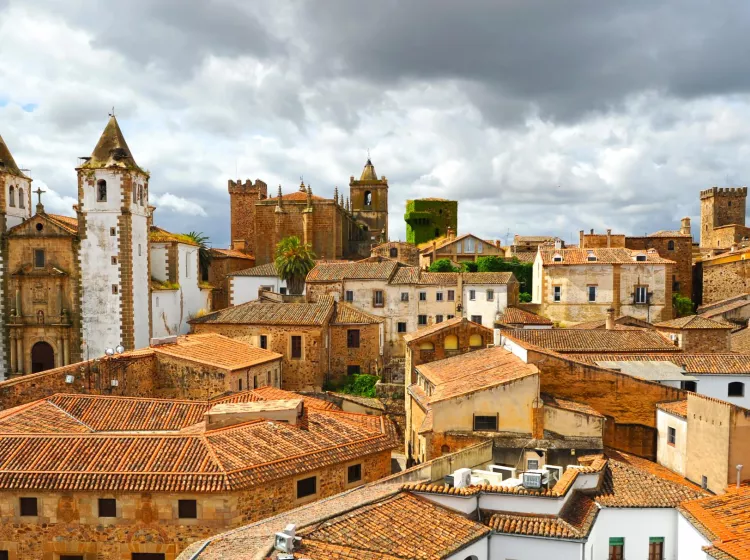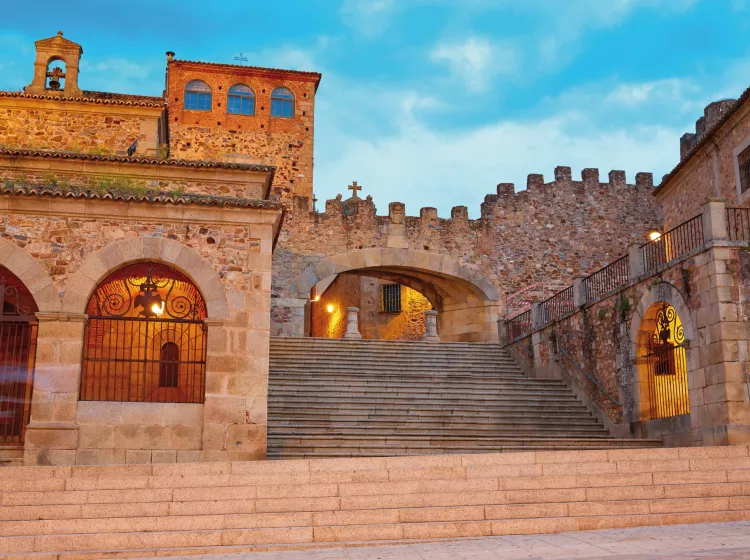
Welcome to the land of water, of large holm and cork oak meadowlands; of traditions and legends. Extremadura goes hand in hand with nature, historical and art heritage, tourism and gastronomy. Two united provinces trace the outline of an idyllic land where you can discover a different way of looking at life.
Cáceres was founded by the Romans and inhabited by different cultures, and still preserves its 12th-century Moorish wall. Its old town is made up of mediaeval streets in a mixture of Gothic and Renaissance styles, with about thirty spires, stately homes and emblematic buildings in one of the best-conserved historic sites in Spain.

A city at your fingertips
In spite of the growth experienced over the last three decades, Cáceres is accessible to everyone, a city that can be explored on foot, with numerous festivals to be enjoyed throughout the year such as San Blas, the Semana Santa Easter Week –listed as a site of International Tourist Interest– or San Jorge.

Culture
Cáceres was a candidate for European Capital of Culture in 2016 and stages internationally prestigious events such as the Womad Festival or the Mediaeval Market of the Three Cultures. Every year the programme includes numerous concerts, a film festival and a classic theatre festival, and since 2021 it has the Helga de Alvear Museum of Contemporary Art, among others, such as the Museo Vostell in the nearby village of Malpartida de Cáceres.

Heritage
The beautifully preserved monumental city is home to streets, plazas, churches and stately homes that bring to life the three cultures to have left their mark on the city: Christian, Muslim and Jewish. They have opened the door to promoting Cáceres as a film set.

Natural environment
At the city gates we find the area of Los Llanos de Cáceres and Sierra de Fuentes, protected natural spaces listed as special protection areas for birds (ZEPA) and included within the Network of Protected Natural Spaces of Extremadura as a Special Protection Area, with two reservoirs, one on the river Guadiloba and another one on the river Salor, plus the Natural Monument of Los Barruecos in Malpartida de Cáceres.

Gastronomy
Cáceres was Spanish Gastronomy Capital in 2015. Considered a standard-bearer of gastronomic excellence in Extremadura, the cuisine of the capital city of Cáceres enjoys considerable prestige across the entire country and boasts the only three-star Michelin restaurant in the region.

How to get there
Bus
Cáceres bus station is opposite the Conference Centre and operates routes to cities such as Madrid, Seville, Mérida and Badajoz, among others.
Car
The A-58 Highway connects Trujillo with Cáceres from the A-5 (Madrid-Lisbon). If we travel via the Ruta de la Plata, the A-66 highway covers the route between Gijón and Seville, passing through Cáceres.
Train
The railway station, just a few metres from the Conference Centre, connects with the cities of Madrid, Badajoz, Mérida, Seville or Lisbon. The gradual deployment of high-speed rail now boasts a modern, highly efficient service.
Air
To reach Cáceres there are direct flights from the cities of Madrid, Barcelona and Palma de Mallorca to Badajoz airport (BJZ), which is 90 Km from Cáceres.
